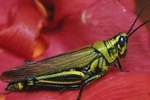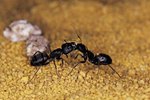
Moths and butterflies share many characteristics -- they're both of the taxonomic order Lepidoptera -- and they have plenty of differences. Both have antennae, for example, but butterfly antennae are different from moth antennae in many ways.
Shape
The divergent shapes of moth and butterfly antennae help distinguish between the creatures. Moths usually have feathered antennae in pointed oval shapes. They are thicker in the middle than at either end. Butterflies tend to have long, thin antennae, but the ends have a special feature -- they end in a ball or club shape, almost like the end of a golf club.
Feathering
When you compare the heads of moths and butterflies, there's usually an obvious difference: feathering on the antennae. Moths have feathering, butterflies don't. The feathering can be easy to see, looking almost like combs or saws on either side of the stems, or more subtle, with tiny hairs covering the thin antenna stems. Butterflies have no feathering, with antennae that look almost like black wire.
Positioning
When moths and butterflies fly, both hold their antennae out and up slightly so they extend beyond their heads. When taking breaks, however, some moths rest their antennae. They lean the antennae back, resting them along their backs or sides. Not all moths rest their antennae, but no butterflies do.
Uses
Butterflies and moths use their antennae for similar purposes, including smelling and finding their way. They use both antennae together to keep them oriented during flight and to detect pheromones of a potential mate. Although both have strong olfactory senses in their antennae, moths with large feathered antennae tend to have a much more powerful senses of smell than butterflies. Each little hair along the antennae has scent receptors. Some male moths can smell a potential mate more than six miles away.
References
- Library of Congress: How Can You Tell the Difference Between a Butterfly and a Moth?
- Cambridge Butterfly Conservancy: Butterfly vs. Moth: What Is the Difference?
- Children's Butterfly Site: What Is the Difference Between Butterflies and Moths?
- Nebraska Game Parks: Butterflies and Moths
- Ask Nature: Antennae Used to Detect Pheromones, Find Mates: Moths
- Enchanted Learning: Butterfly Anatomy
Photo Credits
-
Hemera Technologies/PhotoObjects.net/Getty Images




